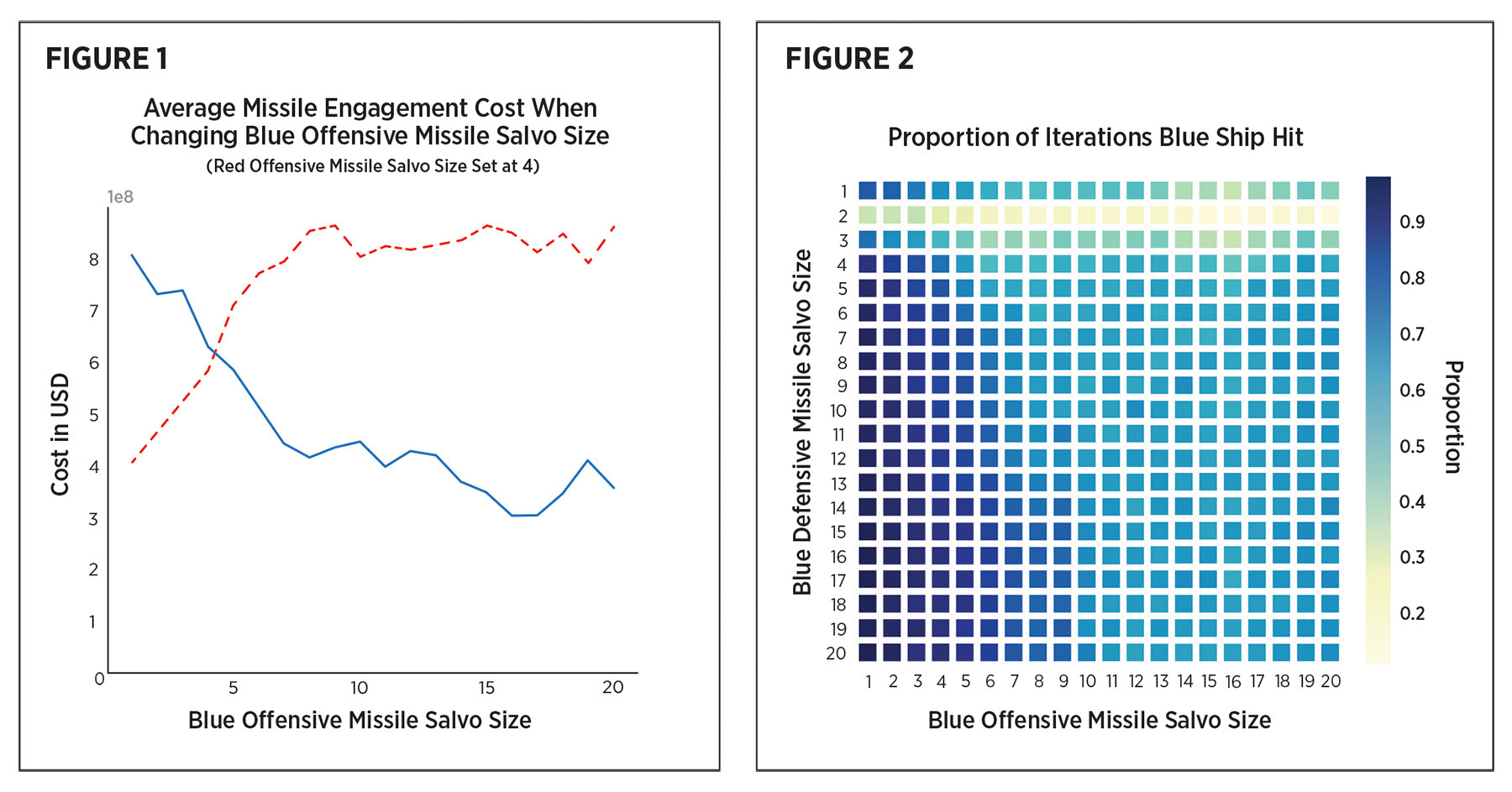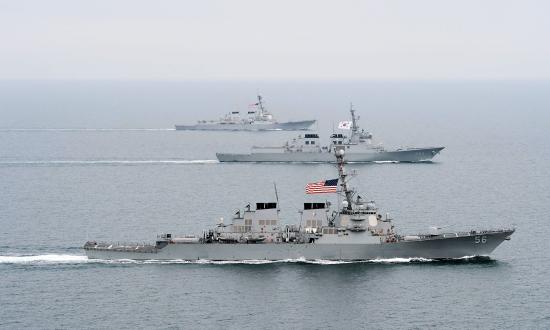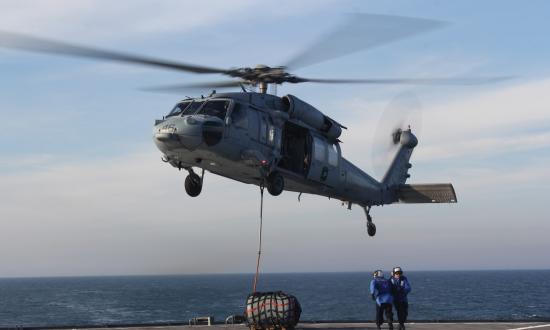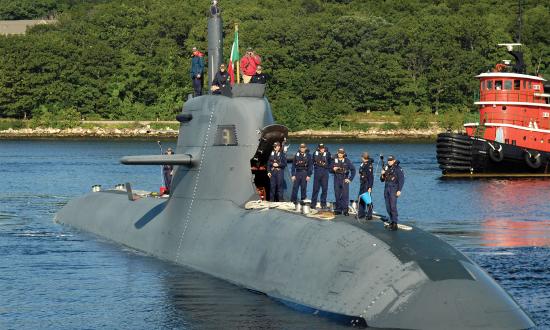As with competitive sports, maritime warfare sometimes demonstrates that offense is the best defense. When two adversary surface ships enter engagement range, each intent on destroying the other, both with intelligence, surveillance, and reconnaissance (ISR) support and a full arsenal of offensive and defensive missiles, which ship usually wins the engagement? A simulation exploring different outcomes of such an engagement shows the value of offense over defense in a missile exchange.
Potential adversary navies have longer range antiship missiles than those currently on U.S. Navy ships. Given the United States’ focus on diplomacy and emphasis on limiting casualties in warfare, the Navy has invested more heavily in state-of-the-art defensive systems than in offensive weapon capabilities.1 The biggest example of this sustained emphasis on defense is the Aegis system and its integrated components.
However, as retired Rear Admiral Robert P. Girrier and the late Captain Wayne P. Hughes observed, the ability to fire first is highly correlated with successful kinetic battle encounters:
Tactical success depends on well-timed action. The goal of opposing tactical commanders is to maximize the offensive firepower that a navy actually delivers. We emphasize delivers as a reminder that staying power matters, especially these days, with the use of missiles, when it has become difficult to keep even a large warship in the action once it has been hit. As Russian Vice Admiral Stephan O. Makarov wrote many years ago, “A good gun causes victory, armor only postpones defeat.” No fleet can operate indefinitely in the face of a competitive enemy without destroying its force.2
Jeffrey Kline, a retired surface warfare officer and current professor of practice at the Naval Postgraduate School in Monterey, California, presented the question, “Which is the most cost-effective way to protect a combatant, defensive measures or offensive strike?” He hypothesized that using offensive measures is more cost-effective than traditional defensive measures as a means of sustained lethality.
To explore Kline’s hypothesis and shed light on Navy options in possible future engagements, with help from Princeton University and Naval Postgraduate School advisors, I created a mathematical model and simulation for a surface-to-surface missile engagement. Navy surface missile engagements are incredibly nuanced, involving two or more operational commanders making a myriad of split-second decisions. Thus, in an effort to limit the scope of the project, we established a set of assumptions for the model.
We assumed there are only two actors: the Blue ship (friendly) and the Red ship (enemy). Each ship has offensive missiles, defensive missiles, and point-defense measures: Evolved Seasparrow Missiles (ESSMs), Sea Rolling Airframe Missiles (SeaRAMs), and a close-in weapon system (CIWS). Each weapon has generic specifications, such as speed and cost, for the iterations of the simulation we ran. The model also incorporates ISR equipment to facilitate the split-second decisions simulated in the engagement. The goal of the simulation was to minimize the cost of the engagement, which includes the cost of the missiles fired and the loss of the ship and crew, and the proportion of iterations the Blue ship is hit. We assumed the engagement begins when the first ship fires a salvo of missiles.
The model was structured using Princeton Professor Warren B. Powell’s five-component mathematical framework, which enabled the simulation to imitate decisions that would be made by sailors and by systems during a missile engagement.3 The simulation steps forward in 15-second intervals from the first salvo of missiles fired until either ship is hit or both run out of missiles. During each time step, both actors analyze the other’s actions and make decisions according to the policies outlined in the model. For example, the number of missiles shot and the time the missiles are fired are decision policies in the model that can be manipulated. As the goal of the model is to avoid loss of the ship and minimize cost to Blue over the simulation, between simulations we altered inputs that gave the actors various capabilities and outlined the actors’ decision policies. Some of the changing inputs include: starting ship location; numbers of all offensive and defensive measures in ship inventories and corresponding success probabilities; ship speed; missile speed; offensive missile range; salvo sizes of all offensive and defensive measures; and whether satellite information is being used.
The model supports Professor Kline’s hypothesis: Improving offensive measures is an effective method of improving defensive capability. Striking first is directly correlated with sustained lethality. Furthermore, the results of the simulations shed light on important conclusions: Greater Blue offensive missile salvo size leads to decreased percentage of simulation iterations in which Blue is hit and decreased cost to Blue. Figure 1 shows the average missile engagement cost (in 100s of million USD) for both Blue and Red when changing the Blue offensive missile salvo size and keeping constant the Red offensive salvo size. The greater Blue’s salvo size, the less cost to Blue. In addition, the optimal defensive salvo size for Blue is two, which is clearly shown by the yellow line in the heat map (Figure 2).
Other policy searches show that if Blue has a greater offensive missile range that allows it to fire offensive missiles sooner, this leads to decreased cost and percentage of simulation iterations that Blue is hit (lost). Greater offensive missile success probability is also advantageous for Blue. The optimal setup for satellite use for Blue is when Blue uses satellite capabilities but Red does not, because Blue can out-detect Red. Finally, after many alterations to policies, we ran the simulation with a combination of all the optimized policies that we found for Blue. The optimized simulation decreased the proportion of simulations the Blue ship was hit and increased the proportion of simulations the Red ship was hit.
Milliseconds Matter
Another interesting result of this research was reaffirming the importance of fractions of seconds in the success of engagements in today’s technology-driven world. Milliseconds are crucial to the success of each “player” in this simulation. Originally, at each time-step of the simulation, Blue was able to make decisions first. This had a huge impact on the results of the simulation, with Blue winning significantly more even when running the simulation with all the same inputs as Red. We fixed this issue by randomizing which player is able to make decisions first during each 15-second time period. With this randomization and using the same inputs, Blue and Red win with about equal probability, as should be the case. This observation further proves the point that the ability to fire first and make decisions first is essential to success in a missile engagement. This same concept is well-known to high-frequency traders on Wall Street, who spend hundreds of millions of dollars to save milliseconds on business transactions.4
This work demonstrates, through exploration of various concepts of employment and millions of simulations, that using offensive measures is advantageous as a defensive method of sustained lethality. As the authors of Fleet Tactics and Naval Operations assert, saving time is essential in war:
Mahan wisely stated that “the true speed of war is . . . the unremitting energy which wastes no time.” Failures to consummate opportunities were failures to communicate and comprehend clearly. The speed that mattered was in the realm of decision-making: decisions had to be made quickly and transformed into simple, correct maneuvers.5
Offensive tactics and technologies must be the Navy’s focus to save time, money, and lives and to remain a leading, lethal force.
Note: This article is adapted from the author’s Princeton University senior thesis, “A Multi-agent Stochastic Control Model for Adversarial Planning in Naval Operations,” and the recently published article in the Military Operations Research Society’s Phalanx, “A Multi-agent Stochastic Control Model for Adversarial Planning in Naval Operations: Cost Effectiveness of the Offense as a Ship Self-Defense Tactic.”6
1. CAPT Jeffrey E. Kline, USN (Ret.), in discussion with the author, 2019.
2. CAPT Wayne P. Hughes Jr., USN (Ret.), and RADM Robert P. Girrier, USN (Ret.), Fleet Tactics and Naval Operations, 3rd. ed. (Annapolis, MD: Naval Institute Press, 2018), 295.
3. Warren B. Powell, Sequential Decision Analytics and Modeling: Modeling Exercises with Python, 20 August 2018.
4. Alexander Osipovich, “NYSE Antennas Spark High-Speed Trader Backlash,” The Wall Street Journal, 8 August 2019.
5. Hughes and Girrier, Fleet Tactics and Naval Operations, 73.
6. Kara Dowling, “A Multi-agent Stochastic Control Model for Adversarial Planning in Naval Operations,” undergraduate thesis 2020, Princeton University, arks.princeton.edu/ark:/88435/dsp01dz010t09b; Kara E. Dowling, “A Multi-agent Stochastic Control Model for Adversarial Planning in Naval Operations: Cost Effectiveness of the Offense as a Ship Self-Defense Tactic,” Phalanx 53, no. 3 (September 2020) 34–38.







